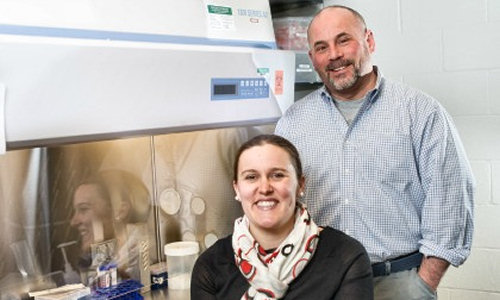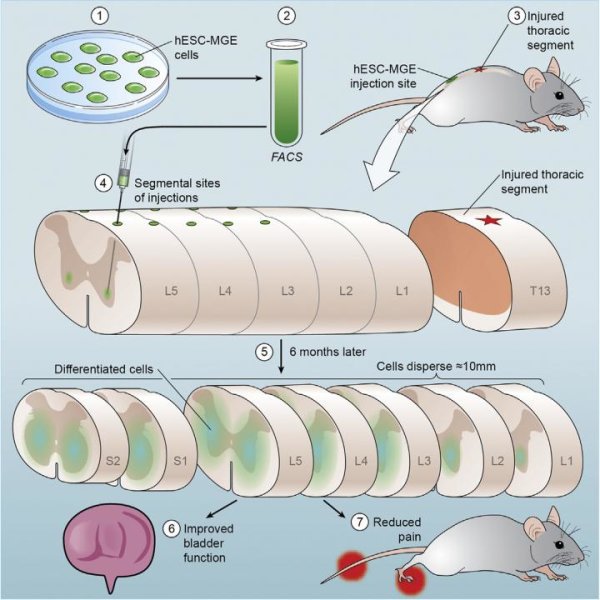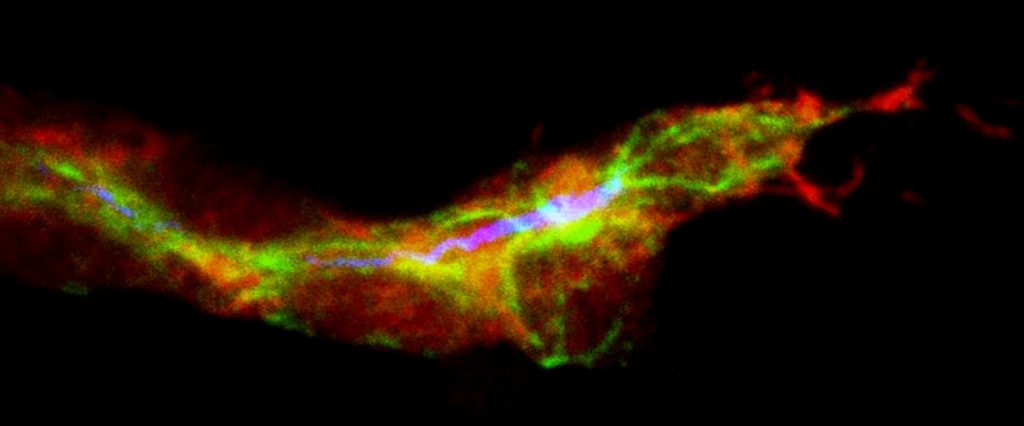In end-stage lung disease, transplantation is sometimes the only viable therapeutic option, but organ availability is limited and rejection presents an additional challenge. Innovative research efforts in the field of tissue regeneration, including pioneering discoveries by University of Vermont Professor of Medicine Daniel Weiss, M.D., Ph.D., and colleagues, hold promise for this population, which includes an estimated 12.7 million people with chronic obstructive pulmonary disorder (COPD), the third leading cause of death in the U.S.
Darcy Wagner, Ph.D., postdoctoral fellow in medicine/pulmonary, left and Daniel Weiss, M.D., Ph.D., professor of medicine. (Photos: Raj Chawla, UVM Medical Photography)
In the past year alone, Weiss and colleagues published four articles in Biomaterials, the leading bioengineering journal, as well as two March 2014 articles by first author Darcy Wagner, Ph.D., a postdoctoral fellow working in Weiss’ lab, reporting their development of new methods and techniques for engineering lungs for patients with COPD and pulmonary fibrosis.
Weiss and his team’s work focuses on lung tissue bioengineering, which involves the use of a scaffold – or framework – of lungs from human cadavers to engineer new lungs for patients with end-stage disease. Their studies have examined multiple perspectives on the process of stripping the cellular material from these lungs – called decellularizing – and replacing it with stem cells (recellularization), in an effort to grow new, healthy lungs for transplantation.
Working in animal and human models, Wagner, Weiss and colleagues have addressed numerous challenges faced during the lung tissue bioengineering process, such as the storage and sterilization of decellularized cadaveric scaffolds and the impact of the age and disease state of donor lungs on these processes.
In one of the latest Biomaterials studies, the researchers report on novel techniques that increase the ability to perform high-throughput studies of human lungs.
“It’s expensive and difficult to repopulate an entire human lung at one time, and, unlike in mouse models, this doesn’t readily allow the study of multiple conditions, such as cell types, growth factors, and environmental influences like mechanical stretch – normal breathing motions – that will all affect successful lung recellularization,” explains Weiss.
To address this, Wagner developed a technique to dissect out and recellularize multiple, small segments in a biological/physiological manner that would take into consideration the appropriate three-dimensional interaction of blood vessels with the lung’s airways and air sacs.
Working with biomaterials scientist Rachel Oldinski, Ph.D., UVM assistant professor of engineering, they further developed a new method using a nontoxic, natural polymer derived from seaweed to use as a coating for each lung segment prior to recellularization. This process allowed the team to selectively inject new stem cells into the small decellularized lung segments while preserving vascular and airway channels. Use of this technique, which resulted in a higher retention of human stem cells in both porcine (pig) and human scaffolds, allows the small lung segments to be ventilated for use in the study of stretch effects on stem cell differentiation.
“The ability to perform numerous experiments and screen multiple conditions from a single decellularized human lung provides an avenue to accelerate progress towards the eventual goal of regenerating functional lung tissue for transplantation,” says Wagner.
Through another novel technique – thermography or thermal imaging – Wagner and colleagues developed a non-invasive and non-destructive means for monitoring the lung scaffolds’ integrity and physiologic attributes in real-time during the decellularization process. According to Wagner, this method could be used as a first step in evaluating whether the lungs and eventual scaffolds are suitable for recellularization and transplantation.
The development of these new techniques are “a significant step forward” in the field of lung regeneration, say Wagner and her coauthors.
This study and Weiss’ and Wagner’s related publications over the past 15 months showcase the positive impact of the $4.26 million National Institutes of Health (NIH) Director’s Opportunity for Research grant Weiss received in October 2010 as part of the American Recovery and Reinvestment Act funding. In addition to these scientific accomplishments, he’s forged strong industry ties, as well, and has several patents pending.
“This work serves as a core for helping develop a robust bioengineering effort to parallel ongoing stem cell activities in the Department of Medicine and for fostering increasing collaborative efforts between the Colleges of Medicine and Engineering,” says Weiss.
Story Source:
The above story is based on materials provided by University of Vermont, Jennifer Nachbur.





